Rig trim: Trimming the backstay - understanding and optimising tensioner systems
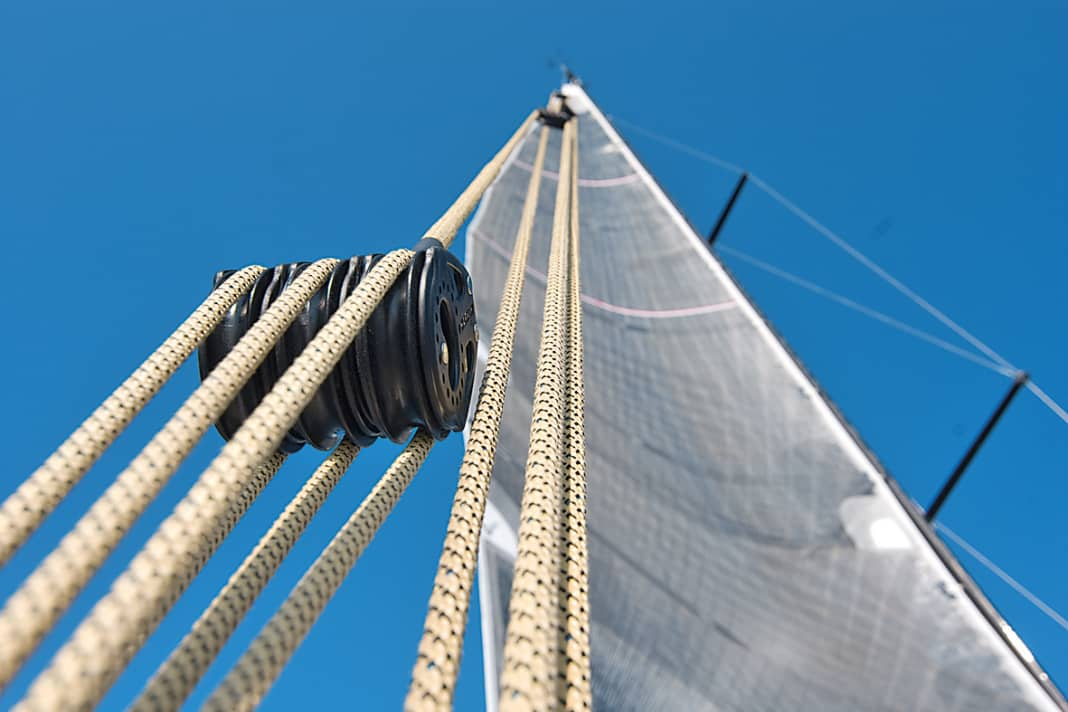





Hardly any other trim function can change the sailing behaviour of a yacht as much as the setting of the backstay. Even on top-rigged boats with their less trim-friendly rigs, changing the backstay tension results in complex changes to the sail profile. This mainly affects the headsail.
If you increase the tension at the stern, the tension on the forestay also increases. This in turn means that the luff of the genoa sags less. The profile depth of the sail decreases and the leading edge becomes flatter. Trimmed in this way, the headsail not only heels less, it can also be sailed higher upwind, although more precise steering is required.
Incidentally, the less the forestay sags, the better the furling system works. The backstay should therefore be as tight as possible, especially in strong winds.
Backstay: How much tension is needed
Conversely, lower backstay tension makes for a fuller headsail that pulls better through the waves in light and medium winds with easier steering at the cross, as the leading edge is rounder and the current breaks less quickly - a setting that also has advantages for autopilot steering.
More about rig trim:
The breaking load of the wire serves as a guide for the required trimming forces. The basic load of the backstay should be around 15 per cent of the breaking load. For a 7-millimetre rig, this corresponds to approximately 620 kilograms. The maximum tension is around 30 percent of the breaking load, which in our example for a 31-foot yacht is around 1.2 tonnes.
The easiest way to achieve such forces is with threaded or crank tensioners. Taljen systems should have at least a 32-fold reduction ratio. However, the calculation also makes it clear that very high loads have to be handled quickly on larger ships, so that hydraulic systems are generally required from 40 feet upwards.
Make the bend: Setting the mast curve
There is hardly any change for the mainsail on top-rigged yachts. Additional tension on the backstay increases the compression pressure on the mast, but as this is usually fixed by the front and rear lower shrouds, the tube can hardly bend, which is why the mainsail profile remains virtually unchanged. The mast curve can only be trimmed with an adjustable baby stay.
The backstay has an even greater influence on the trim of partial rigs, i.e. the attachment point of the forestay is below the backstay. The spectrum ranges from the 3/4 rigging of the Folke boat to the 7/8 rigging popular in the eighties and nineties to the currently popular 9/10 variant. With these rigs, the greater or lesser distance between the masthead and forestay creates a bending moment; additional tension on the backstay not only increases the forestay tension, but also changes the mast curve.
This has consequences for the mainsail. The effects are greatest with 7/8 rigs with neutral spreaders, i.e. not angled. If the backstay is set, the masthead moves backwards and the leech of the mainsail opens. At the same time, the centre section of the mast bends forwards and pulls the sail flatter. This is ideal for taking pressure off the boat in stronger winds without having to reef immediately. With a correctly dimensioned jib, this works so well that even gusts can be trimmed out.
The baking racks are not required for swept spreaders
As the forestay tension in this type of rig is taken over by the backstays and the backstay only bends the mast, the required trimming forces are significantly lower. On a 35-foot boat, a maximum tension of 400 kilograms should be sufficient. This can be achieved with a reduction ratio of 12:1.
The situation is different if the spreaders are swept. In this configuration, the forestay tension is taken over by the upper shrouds and the backstay. In addition, the mast is held at spreader height by the aft lower shrouds. This eliminates the need for back stays; however, the mast cannot be bent as easily, and more reduced backstay tensioners are required.
If the forestay is also moved up a little, the result is the currently popular 9/10 rig, a compromise between a top and 7/8 rig. The backstay takes over a larger part of the forestay tension, which means that the sag can be well controlled even without backstays. On the other hand, the shorter lever means that the mast bend cannot be adjusted as easily as with a 7/8 rig. However, the backstay influences the mainsail profile and, compared to a top rig, the baby stay required for trimming is no longer necessary.
Backstay adjustment with tackle system
In addition, operating comfort is increased: a pull on the backstay flattens the foresail and mainsail at the same time, and pressure can be taken off the boat very easily.
However, the 9/10 configuration also generates significantly greater forces. Yachts around 37 feet should be able to put about one tonne on the stay. Assuming that a line can be pulled by hand with around 30 kilograms, this results in gear ratios of at least 32:1. As friction losses inevitably occur, a 48:1 variant is the more comfortable choice.
More on the subject of trim:
The best way to realise such strong valley buoy systems is with several folding runners, for example three cascades and a six-fold valley buoy. The advantage of this is that each cascade doubles the force and at the same time halves the required breaking load of the blocks attached underneath. The backstay of a 37-foot yacht should be designed for a breaking load of around four tonnes. The top block must be able to withstand at least this. In the next stage, two tonnes are already sufficient, and the six-fold spreader only requires a breaking load of 500 kilograms - a value that practically all common triple blocks with 50 or 60 mm discs achieve.
Thimbles or blocks for the backstay tensioning system?
All the more important is the bearing of the deflector. If you want to trim comfortably, you should use ball bearings, at least for the six-point jib. For the more heavily loaded cascades, only plain bearings or very expensive high-load blocks are usually considered.
Although thimbles are cheaper, they generate significantly more friction and should therefore only be used as the uppermost deflection. This should also be borne in mind when upgrading an existing hawse system. Here is an example: There is an existing quadruple hawser with a folding traveller. In order to increase the reduction ratio, the tackle can be replaced with a six-fold version; this increases the overall ratio from 8 to 12:1. Advantage: The existing stay and folding traveller remain unchanged. However, two triple blocks have to be purchased and two additional deflections increase the friction.
If an additional cascade is inserted instead, the overall ratio doubles to 16:1, with only one additional deflection increasing the friction. In order not to disturb the breaking load structure, the new block should be inserted directly above the existing tackle. However, the lengths of the backstay and the existing folding traveller must be adjusted. If a thimble is chosen at this point, its friction can cancel out the gain of the additional step.
The easiest and quickest possible adjustment is important for backstay trim
If you want to utilise the full potential of your boat, you need to be able to adjust the backstay tension to the wind and weather conditions.
For top-rigged yachts, a spindle or crank tensioner is usually sufficient, as the forestay sag is always a hindrance except in light winds, even if it is only because the furling system becomes stiff and the genoa cannot be reefed properly when the wind increases. Rapid tension changes are not absolutely necessary, it is more a matter of relieving the rig after sailing.
With all other rig types, the backstay also influences the mainsail trim; it should be as easy and quick to adjust as possible. On a course with changing angles of incidence, a touring skipper will not suddenly take the tension out of the rig after dropping it in order to adjust it again just as quickly the next time the sail is hoisted.
However, if reefing can be delayed by a simple pull on the backstay and the boat sails faster and higher, this not only increases the fun at the tiller or wheel, but also increases sailing comfort for the whole crew.
Trim the different rig types correctly
Top rig
- The tension on the backstay influences the sag of the forestay and the maximum height upwind
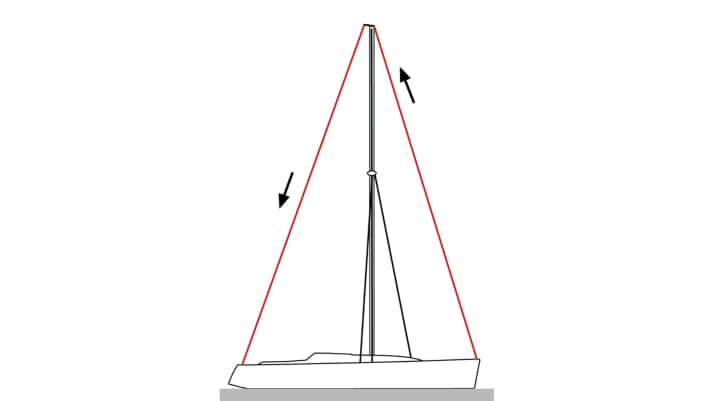
The backstay holds the mast in place and is always kept tight. Depending on the wind conditions, the tension should be between 15 and 30 per cent of the breaking load. Due to the different angles of attack between the backstay and forestay, the latter usually receives 30 to 40 per cent more tension than the tensioner at the stern.
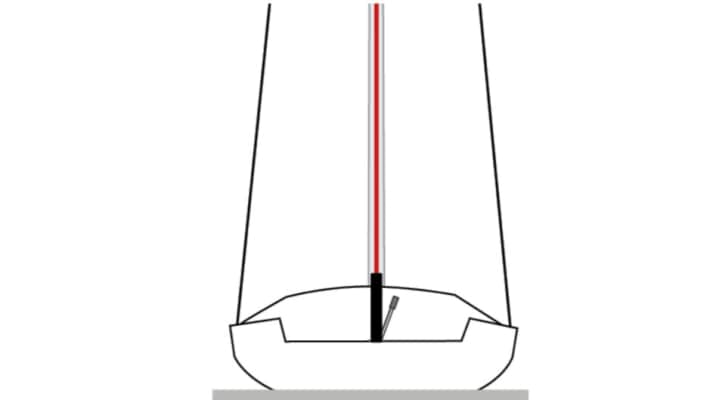
With top rigs, the backstay determines the forestay tension and thus the profile of the headsail. This requires relatively high loads to be managed. However, the trim usually only needs to be changed slowly. Ideal for mechanical tensioners; from 35 feet upwards, a hydraulic cylinder can also be of interest, allowing the stay to be adjusted very easily. Buoy solutions are possible, but must be heavily geared. When using high-quality blocks, they are hardly cheaper than a simple tensioner with folding handles.
9/10 rig
- The profile and twist of the mainsail and the forestay tension are changed simultaneously
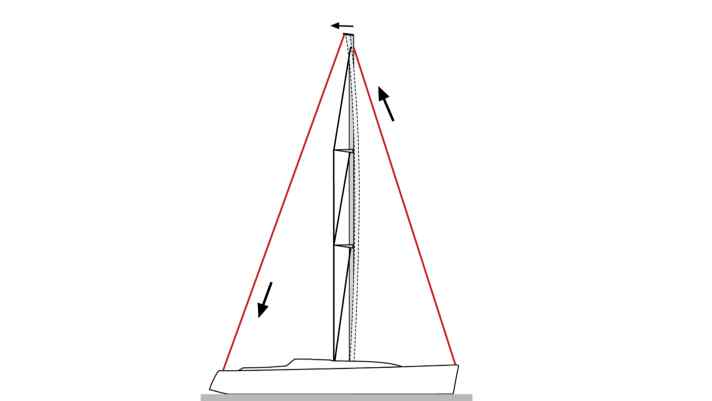
The mast is held by the shrouds thanks to the swept spreaders. The backstay bends the mast and increases the forestay tension at the same time. The possible mast curve is limited by the lower shrouds. To avoid a negative curve, the backstay must not be completely released when sailing.

The swept spreaders increase the longitudinal rigidity of the rig. As the backstay also acts with a relatively short lever above the forestay, a strong tensioner is required to bend the mast. Even on a 37-foot yacht, up to a tonne of tension may be required. The bend changes the profile and twist of the mainsail, so it should be possible to adapt quickly to changes in wind or course. Depending on the size of the boat, tackle systems with gear ratios of 24 to 48:1 or hydraulics are the first choice.
7/8 rig
- Only the mainsail is trimmed with the backstay. The forestay tension is provided by backstays or shrouds
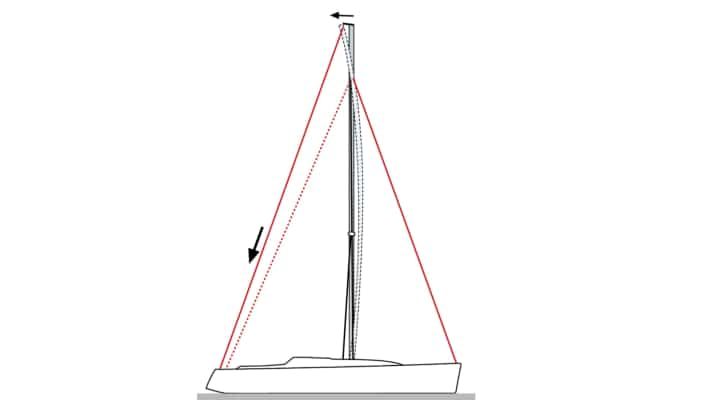
7/8 rigs are usually very flexible. The backstay bends the mast. The forestay tension is controlled by the backstays or, in the case of swept spreaders, by the upper shrouds. The trim of the centre backstay has hardly any influence on the sag of the forestay.
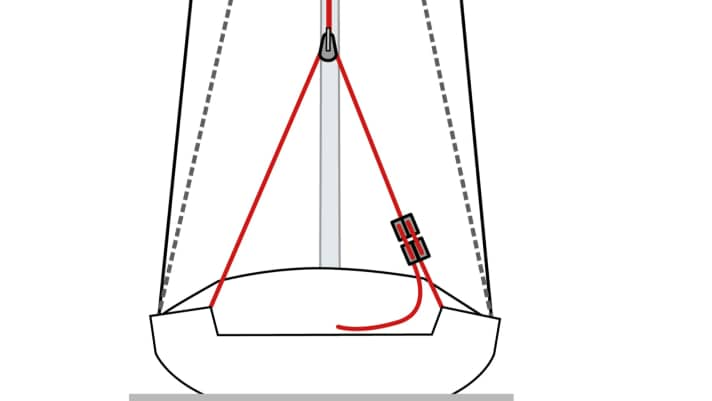
Thanks to the long lever between the masthead and forestay fitting, the mast curve can be changed with little force. For a 35-foot yacht, a tackle with a folding traveller and a reduction ratio of 8 or 12:1 is usually sufficient to easily adjust the mainsail profile to different wind conditions. Since comparatively much travel is required, crank tensioners are unsuitable. Hydraulic solutions are possible, but only make sense on very large boats due to the relatively low loads
The right backstay tensioning system for every ship and every requirement
Hydraulic integral clamps
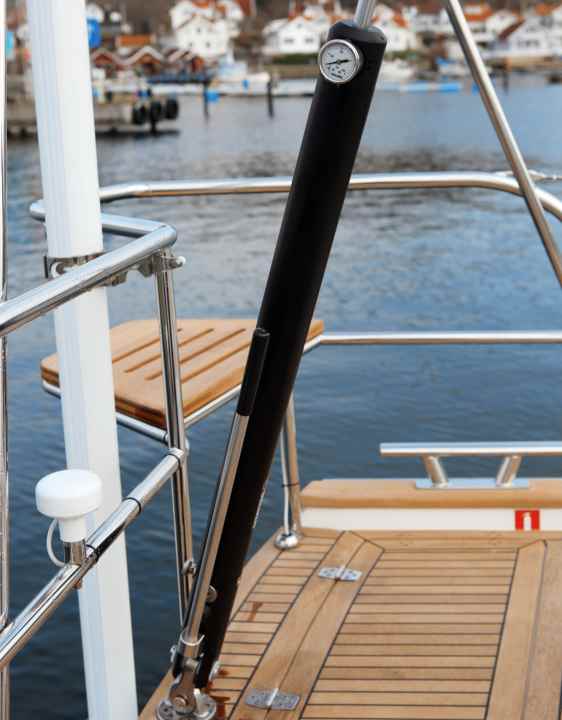
Hydraulic integral tensioners are very powerful and easy to install. The pump, oil reservoir and cylinder are in one housing. The pressure gauge shows the tension on the stay. It can be quickly depressurised using a valve. Prices for 6-millimetre stays from 2,200 euros
Crank tensioner
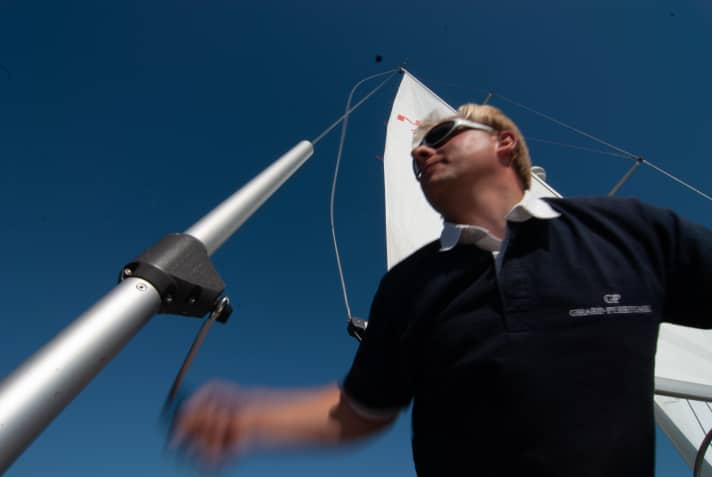
Crank tensioners are suitable for rods with a diameter of 6 to 10 millimetres and deliver around three tonnes of pulling force. They also need to be cranked to release the load, which is why they are not ideal for active trimming. Prices start at around 700 euros
Tensioner with folding handle
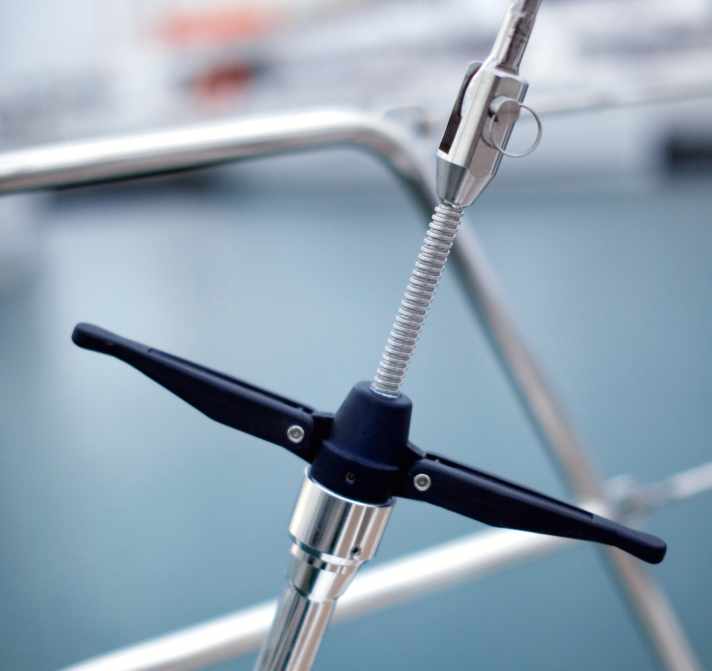
Clamps with fold-out handles are comparatively inexpensive and are also available for thinner wires. A variant for 6-millimetre wire costs around 350 euros. This is definitely an option for top-rigged yachts and much better than simple shroud tensioners
Talj system
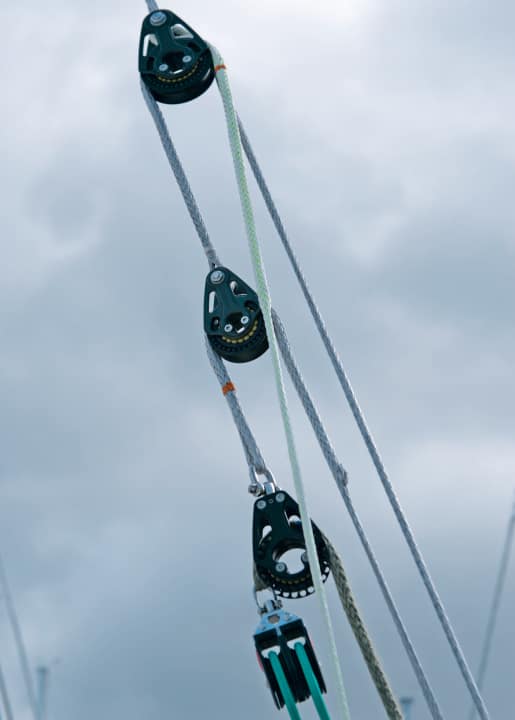
Reduction ratios of up to 48:1 can be easily achieved with buoys. To minimise friction, folding rotors should be used. The working load of the blocks can be adjusted in each cascade, which reduces costs. Nevertheless, a 48-gear system costs around 800 euros
Dyneema instead of wire? The right material for the backstay
Single braids made from Dyneema SK78 fibres already offer a higher breaking load than wire with the same diameter, but weigh only a tenth as much. The weight advantage of the prefabricated stay increases even further as the metal terminals are replaced by splices. To minimise stretch, it can make sense to choose cordage that is one size thicker. Alternatively, special braids such as the extremely low-stretch Ultrawire from Maffioli or the STS Ocean 5000 from Teufelberger can be used. These can even be thinner. A rubber strop wrapped around the last few metres helps to prevent the typical humming of textile stays. There is little need to worry about UV resistance with Dyneema, and coated braids are also robust enough mechanically.

